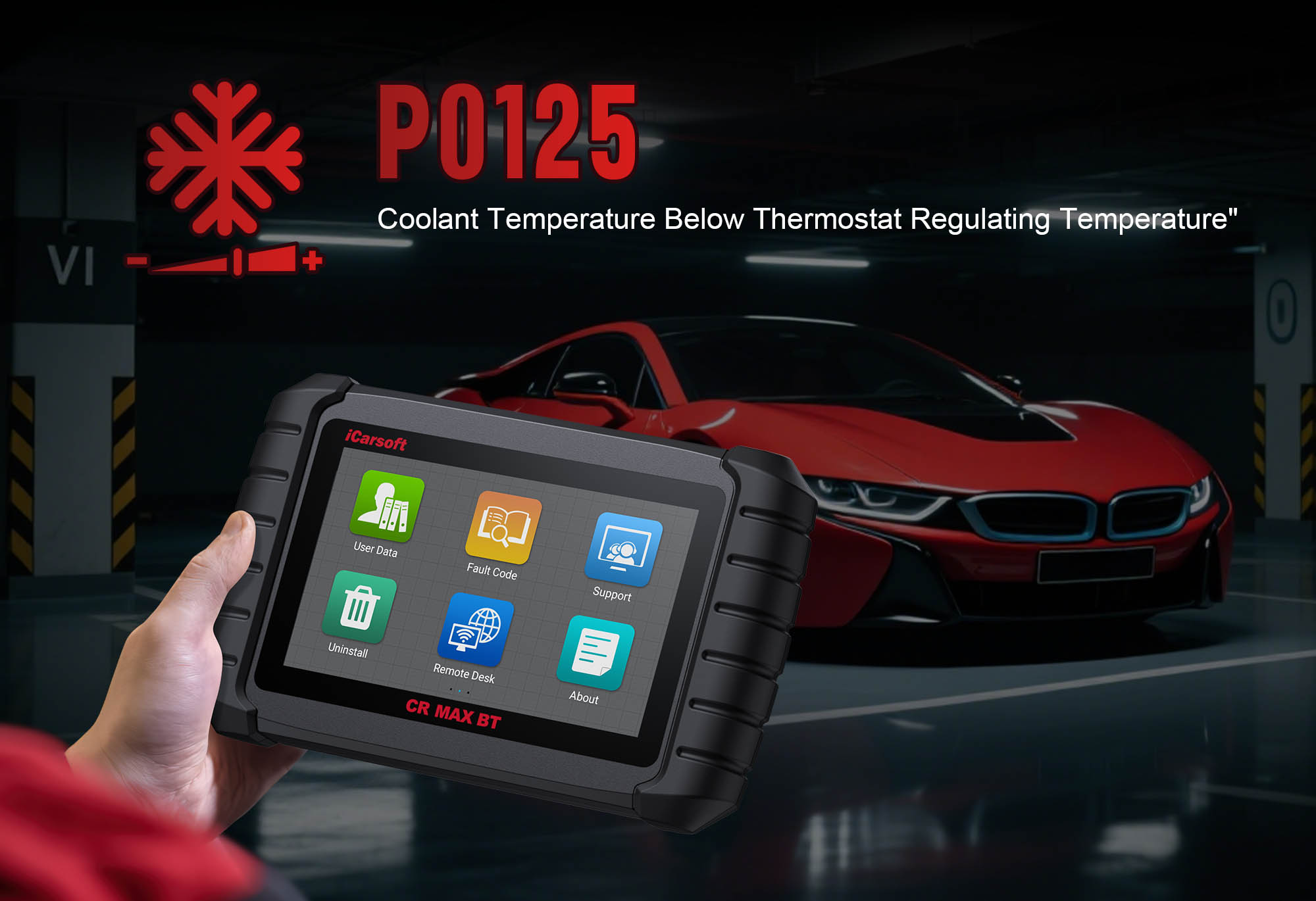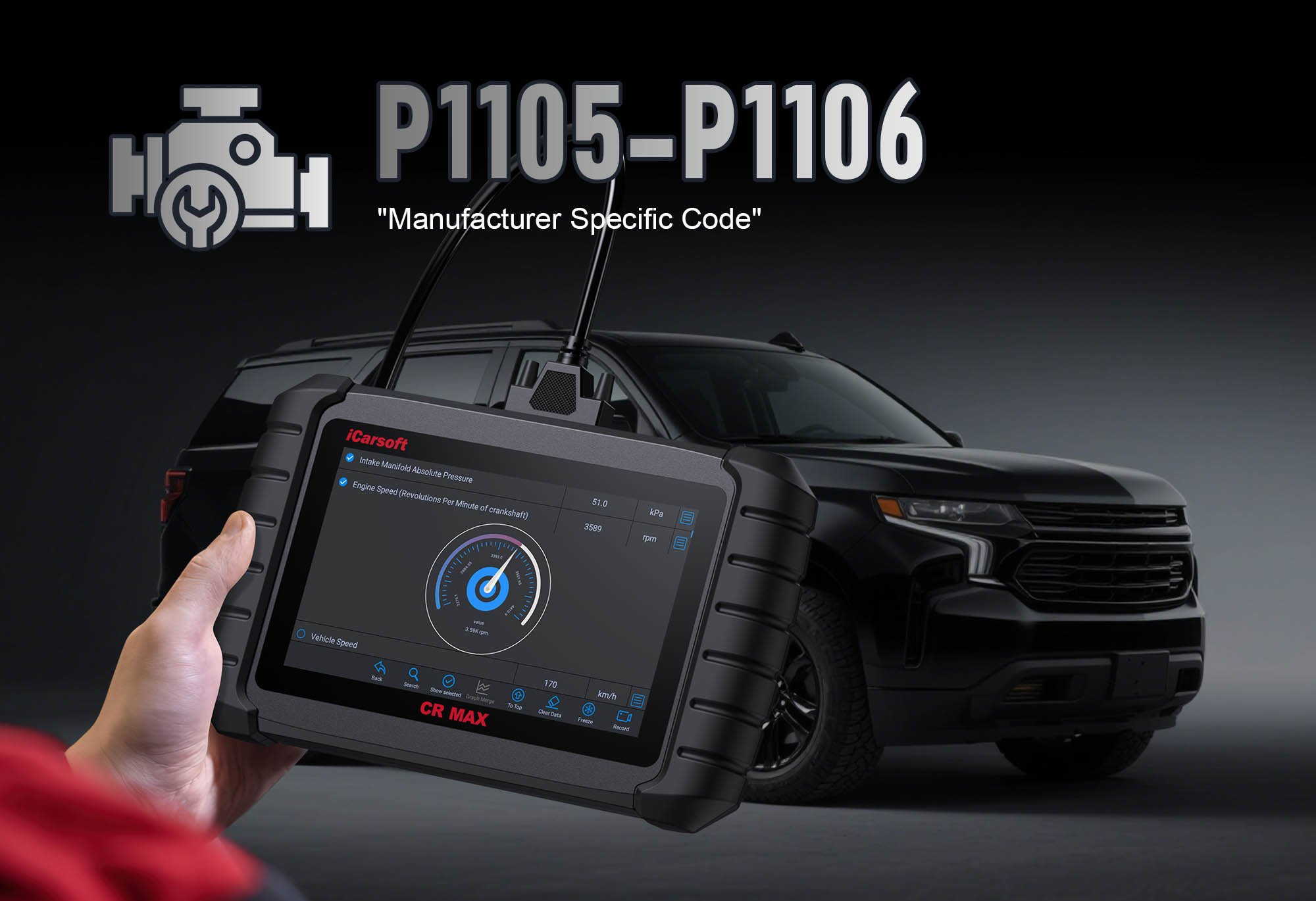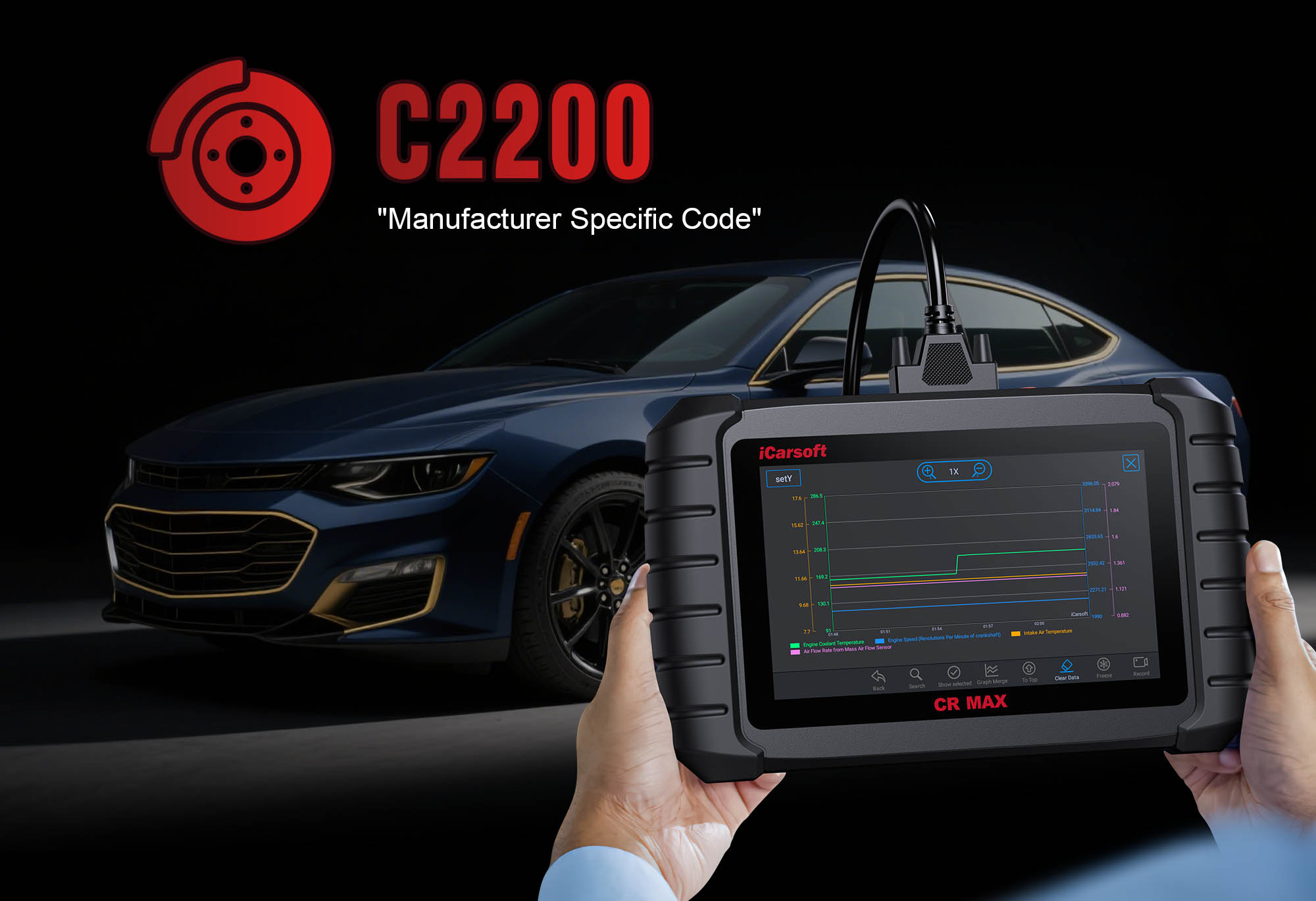P0125 Code: Diagnose & Fix Engine Warm-Up Issues with iCarsoft CR MAX BT
When your check engine light illuminates and a scan returns P0125, your vehicle is signaling a problem with its engine warm-up cycle. This generic OBD-II code stands for “Insufficient Coolant Temperature for Closed Loop Fuel Control”—meaning the engine isn’t reaching its optimal operating temperature (typically 160–200°F / 70–95°C) within the expected time frame. Closed-loop fuel control (where the ECM adjusts fuel delivery via oxygen sensor data) relies on proper warm-up; without it, you’ll face poor fuel economy, rough idle, and increased emissions. This guide breaks down P0125’s causes, symptoms, and how the iCarsoft CR MAX BT simplifies accurate diagnosis and repair.
What Is the P0125 Code?
P0125 centers on the engine’s ability to reach and maintain operating temperature—a critical step for efficient performance. Here’s the breakdown:
-
The Warm-Up Cycle: When starting a cold engine, the thermostat stays closed to trap coolant, accelerating heat-up. Once the engine reaches 160–200°F, the thermostat opens, circulating coolant to prevent overheating.
-
ECT Sensor Role: The Engine Coolant Temperature (ECT) sensor monitors coolant temp and sends data to the ECM. The ECM switches to closed-loop fuel control once temps stabilize—this optimizes fuel-air mixture for efficiency.
-
Code Trigger: P0125 activates if the engine takes too long to reach operating temperature (usually >10–15 minutes) or never reaches it. This tells the ECM it can’t rely on oxygen sensor data for precise fuel adjustments.
Key Symptoms of P0125
-
Poor Fuel Economy: The ECM runs the engine in “open-loop” (rich fuel mixture) longer to compensate for cold temps, increasing gas consumption.
-
Rough Idle Until Warm-Up: The engine shakes or fluctuates in RPM until it (slowly) reaches operating temperature.
-
Lukewarm Heater Air: Insufficiently heated coolant means the heater can’t produce hot air—noticeable in cold weather.
-
Illuminated Check Engine Light: Often paired with P0117 (ECT sensor low input) or P0118 (ECT sensor high input) if the sensor itself is faulty.
-
Slow Acceleration (Cold Engine): The rich fuel mixture causes sluggish performance until the engine warms.
Common Causes of P0125
|
Cause
|
Description
|
|
Stuck-Open Thermostat
|
The most common cause: Fails to close, letting coolant circulate immediately—preventing the engine from trapping heat and reaching operating temp.
|
|
Faulty ECT Sensor
|
Sends incorrect data to the ECM (e.g., reads “cold” when the engine is warm), tricking the ECM into thinking warm-up is incomplete.
|
|
Low Coolant Level
|
Insufficient coolant reduces heat transfer, slowing warm-up and potentially causing air pockets in the system.
|
|
Cooling System Leaks
|
Leaks from hoses, radiator, water pump, or thermostat housing cause coolant loss—mimicking low-level issues and delaying warm-up.
|
|
Water Pump Failure
|
A weak or failing pump can’t circulate coolant efficiently, leading to uneven heat distribution and slow warm-up.
|
Why iCarsoft CR MAX BT Excels at Diagnosing P0125
Basic scanners only flag “coolant temperature issues” but can’t track warm-up trends or test thermostat/ECT sensor functionality. The CR MAX BT solves this with cooling-system-specific tools:
Wireless Bluetooth Connectivity
No cords tie you to the OBD port—move freely to check coolant levels, inspect hoses, or test the thermostat while monitoring real-time temperature data on your phone/tablet.
Real-Time Temperature Tracking
Displays “ECT Sensor Reading,” “Target Operating Temp,” and “Engine Run Time” side-by-side—spot delays instantly (e.g., 20 minutes to reach 160°F).
Vehicle-Specific Cooling Specs
Preloaded with manufacturer data (e.g., Toyota: 180–195°F operating temp; warm-up time <8 minutes) and thermostat opening temps—avoids generic guesswork.
Built-In Cooling System Tests
Runs “Thermostat Function Check” (detects temperature spikes when the thermostat opens) and “ECT Sensor Accuracy Test” (verifies sensor readings against real-world temps).
Leak Detection Guides
Includes pressure test procedures, component locations (radiator, hoses, water pump), and visual inspection tips tailored to your vehicle.
Auto VIN & CAN-FD Support
Automatically detects your vehicle’s make/model/year (e.g., 2022 Honda Civic, 2019 Chevrolet Malibu) and captures fast-changing temperature data—critical for intermittent P0125 cases.
Step-by-Step: Diagnose P0125 with iCarsoft CR MAX BT
-
Connect the CR MAX BT & Confirm P0125
1. Plug the CR MAX BT’s OBD-II adapter into your vehicle’s port (under the dashboard), power on the tool, and pair via Bluetooth (follows on-screen prompts—takes 10–15 seconds).
2. Select your vehicle’s make/model/year using Auto VIN for accurate cooling system specs.
3. Navigate to Engine > Fault Codes > Read Codes to confirm P0125. Tap Code Details for vehicle-specific triggers (e.g., “Honda: ECT <160°F After 12 Minutes of Operation”).
-
Check Coolant Level & Visual Inspection
1. Locate the coolant reservoir using the CR MAX BT’s Component Location tool (usually a translucent tank near the radiator with “MIN/MAX” marks).
2. Check levels only when the engine is cold—levels below “MIN” indicate a low coolant issue.
3. Inspect for leaks: Look for wet spots, stains, or coolant residue around hoses, radiator, water pump, and thermostat housing. Use the tool’s flashlight feature for hard-to-see areas.
4. If low, add the manufacturer-recommended coolant (check the CR MAX BT’s Fluids Guide—e.g., Dex-Cool for GM, Honda Type 2 for Honda).
-
Analyze Real-Time Temperature Data
1. Go to Engine > Live Data > Cooling System and select three key parameters:
- “ECT Sensor Temperature” (real-time coolant temp).
- “Engine Run Time” (tracks how long the engine has been running).
- “Thermostat Status” (on supported models: “Closed”/“Open” to confirm operation).
2. Start the cold engine (not driven for 8+ hours) and monitor data for 15 minutes:
- P0125 Confirmation: Temp rises slowly (e.g., 100°F after 10 minutes) and never reaches your vehicle’s operating range.
- Normal Rise Then Plateau: Temp climbs to 160°F then stalls—signals a stuck-open thermostat.
- Erratic Readings: Temp jumps randomly (e.g., 80°F → 180°F → 100°F)—indicates a faulty ECT sensor.
-
Test the Thermostat & ECT Sensor
1. Thermostat Function Test: - Navigate to Special Functions > Engine > Cooling System > Thermostat Test.
- The tool logs temperature changes over 15 minutes. A healthy thermostat shows a sudden 5–10°F spike when it opens (typically at 180–195°F).
- No spike = thermostat stuck open (needs replacement).
2. ECT Sensor Accuracy Test: - Once the engine is warm (reaches 180°F+), use an infrared thermometer to measure the temperature of the thermostat housing.
- Compare this reading to the CR MAX BT’s “ECT Sensor Temperature”—they should match within 5°F.
- Discrepancy >10°F = faulty ECT sensor (needs replacement).
-
Repair or Replace Faulty Components
Based on test results, address the root cause:
1. Stuck-Open Thermostat: - Use the CR MAX BT’s Maintenance Guide > Thermostat Replacement for step-by-step instructions (includes torque specs, e.g., 18 ft-lbs for most models).
- Drain coolant (follow the tool’s “Coolant Drain Location” guide), remove the old thermostat, install a new one with a fresh gasket, and refill with coolant.
2. Faulty ECT Sensor: - Locate the sensor (usually near the thermostat housing) via the CR MAX BT’s component map.
- Disconnect the electrical connector, unscrew the sensor, and install an OEM replacement (use Part Lookup for part numbers—e.g., Bosch 0280130038).
3. Cooling System Leaks: - Use the tool’s “Leak Detection Tips” to identify the source (e.g., cracked hose, loose clamp). Replace damaged parts and refill coolant to the correct level.
-
Clear P0125 & Verify Repairs
1. Clear the code: Go to Engine > Fault Codes > Clear Codes and delete P0125.
2. Test the warm-up cycle:
- Start the cold engine and let it run, monitoring “ECT Sensor Temperature” on the CR MAX BT. It should reach operating temperature within your vehicle’s specified time (e.g., <10 minutes).
3. Confirm closed-loop operation:
- Navigate to Live Data > Fuel System—look for “Closed Loop” status once the engine is warm (confirms the ECM is using oxygen sensor data).
4. Final verification:
- Take a 20-minute test drive (include highway and city driving). Re-scan for codes—no P0125 = successful repair.
How to Prevent P0125 from Recurring
-
Check Coolant Levels Monthly: Use the CR MAX BT’s Maintenance Reminder to schedule checks—top off with the correct coolant if levels drop below “MIN.”
-
Replace Thermostat Every 80k–100k Miles: Proactive replacement prevents stuck valves (use the tool’s Service Interval tracker to set reminders).
-
Flush Cooling System Every 5 Years: Remove sediment and old coolant that clogs thermostats and damages ECT sensors (follow the CR MAX BT’s Cooling System Flushing Guide).
-
Inspect Hoses & Belts Quarterly: Check for cracks, bulges, or wear—replace aging hoses to prevent leaks (use the tool’s Visual Inspection Checklist).
-
Update ECM Software: Use the CR MAX BT’s One-Key Upgrade to install manufacturer patches—some P0125 cases stem from outdated temperature thresholds.
Conclusion
P0125’s “insufficient coolant temperature” label often traces to simple fixes—like a stuck thermostat or low coolant. The iCarsoft CR MAX BT eliminates guesswork with its wireless tools, real-time temperature tracking, and vehicle-specific guides, helping you avoid unnecessary part replacements (e.g., replacing an ECT sensor when the thermostat is the issue).
Whether you’re a DIYer with a Honda Civic or a technician servicing a Chevrolet Malibu, the CR MAX BT ensures you resolve P0125 quickly. By restoring proper warm-up, you’ll boost fuel efficiency, fix lukewarm heat, and keep your engine running smoothly—saving time and money in the long run.
FAQs About P0125 Code
Q: Can I drive with P0125 temporarily?
A: Yes—short trips (e.g., 10–15 miles) are safe, but prolonged driving reduces fuel economy and may damage the catalytic converter (from rich fuel mixtures). Address P0125 within 1–2 weeks.
Q: How much does it cost to fix P0125?
A: $10–$30 for coolant top-off (DIY); $20–$80 for a thermostat (DIY); $150–$300 for professional thermostat installation; $40–$120 for an ECT sensor (DIY). The CR MAX BT ($150–$250) avoids costly misdiagnosis.
Q: What’s the difference between a faulty ECT sensor and a stuck thermostat?
A: A stuck thermostat causes slow, steady temperature rise (never reaching operating temp). A faulty ECT sensor causes erratic readings (temp jumps randomly) or incorrect data (reads cold when warm). The CR MAX BT’s real-time tracking distinguishes these easily.
Q: Will P0125 clear on its own after fixing the issue?
A: No—you need to clear the code with the CR MAX BT. The ECM won’t automatically reset P0125 even if the warm-up cycle is restored; a manual reset is required.





